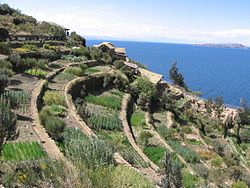Titicaca is a lake located in the Andean plateau region and is shared between Peru is Bolivia
To know
Lake Titicaca is located on the border between Bolivia and Peru, at an altitude of 3,812 meters. It has an area of 8,330 km². Its depth is about 450 m. Its most striking feature is the deep blue color of its waters.
The Titicaca area is the ancestral land of the Quechua, Aymara, Uros, Pacajes, and Puquinas peoples. The lake was the foundation of the most influential pre-Hispanic cultures of the Andean region. Many independent kingdoms grew up in this fertile area starting in the 9th century, although it is interesting to note that most of these kingdoms were ultimately rivals, until the mid-15th century when the Incas conquered the region, which they believed was important for the production of wool and meat. Today, Puno continues its vast agricultural traditions and also its ancestral rites, such as offerings to the Pachamama (Mother Earth), and such ancient customs are omnipresent in the life of the inhabitants of this region.
The Titicaca reserve was created in 1978 with the aim of preserving the flora, fauna and beauty of the surrounding countryside. There are 60 species of birds, 14 species of fish and 18 species of amphibians in the Reserve; one of the most famous is the Titicaca giant frog, which can weigh up to 3 kg.
Lake Titicaca takes its name from the island called Intikjarka, a word that derives from two Aymara and Quechua words: Inti or Sun and kjarka or rock boulder.
Geographical notes
It consists of two water basins separated by the Strait of Taquina. The largest, located to the north is named Lake Mayor or Chucuito, has an area of 6,450 km² and has the maximum depth of the lake (281 m) near the island of Soto. The other smaller basin is called Lake Menor or Huiñamarca, is located to the south and has an area of 2,112 km², and a maximum depth of 45 meters.
It is located at an altitude of 3812 meters above sea level, and is the highest navigable lake in the world.
Territories and tourist destinations
Urban centers
Alla Bolivia the most interesting tourist places belong. These are:
- 1 Copacabana - Located on the peninsula of the west coast, Copacabana is a place with suggestive landscapes that now lives from tourism and also the point where you embark for the two islands described in the next section.
Other destinations
- 1 Isla del Sol - Populated by a thousand Quechua and Aymara natives, Isla del Sol is full of Inca ruins. These include those of a sanctuary dedicated to the sun god (Inti). The finds are housed in the museum of Challapampa.
- 2 - Much smaller than the previous one, the island of the Moon is inhabited by a small number of Quechua families. It also had a sacred character in the Inca era as evidenced by the ruins of sanctuaries.
- 3 Amantaní —
- 4 Taquile —
- Islands of the Uros - Floating artificial islands, created and used by the Uros people.
How to get
On the train
There is a train that in 10 hours moves between Cuzco is Puno. Train tickets can be via the site perurail.com.
By bus
You can reach Lake Titicaca from La Paz (about 3 hours, 3 and a half hours) with one of the minibuses that depart from the cemetery area and terminate at Copacabana or even from Cuzco in Peru until Puno, the largest center on the shores of the lake.
As an alternative to public transport, you can resort to tourist agencies that offer excursions of one or more days. The most renowned (and even the most expensive ones) I'm "Crillons Tours"(telephones in La Paz: 591-2 2337533 or 591-2 2339103) e Transturin (Av. Arce nº 2678. Tel 591-2 242 2222. Fax: 591-2 2411922). Both agencies have buses for travel from La Paz or Puno and hydrofoils for lake cruises.
How to get around
The major attractions in Lake Titicaca are the Isla del Sol and the Isla de la Luna, which are also the largest on the lake. These islands can be reached by ferry from Copacabana. Only the isla del sol is inhabited.
The surroundings can also be visited by train. Tickets can be purchased through the site perurail.com.
What see
What to do
Shopping
Where to eat
Where stay
The best choice in the Peruvian shores is to stay in Puno.
Safety
The lake water is sweet, pure and delicious. However, it is always a good idea to boil it to avoid unpleasant intestinal problems.
Due to the high altitude of Lake Titicaca, headaches are a common complaint among travelers not acclimatized to that altitude. Drinking coca tea is recommended to relieve headaches and to help acclimate.
How to keep in touch
Around
Bolivia
- Copacabana
- Tiahuanaco (or Tiwanaku) - Archaeological site protected byUNESCO.


